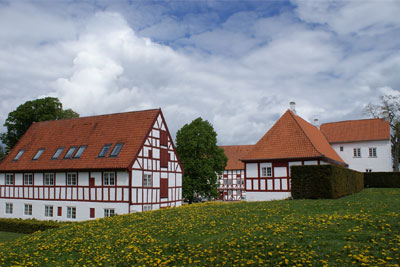Aalborghus Slot
Aalborghus Castle is located near the Limfjord and Toldbod Plads. The beautiful castle park is open every day of the year. In the summer you can visit the castle’s dungeon and underground casemates. This page was last edited on 11 December 2014, at 15:12. Files are available under licenses specified on their description page. All structured data from the file and property namespaces is available under the Creative Commons CC0 License; all unstructured text is available under the Creative Commons Attribution-ShareAlike License; additional terms may apply. Aalborghus Castle is located near the Limfjord and Toldbod Plads. The beautiful castle park is open every day of the year. In the summer you can visit the castle’s dungeon and underground casemates. Hotels & Travel in Aalborg. Aalborghus Castle, translated as ‘Aalborghus Slot’, is a castle and former fortification in the city of Aalborg in Denmark. Built by Christian III between 1539 and 1555, it was intended as the home of the local governor. Today, visitors can tour Aalborghus Castle and, perhaps most interestingly, its dungeons.
Aalborghus Castle (Danish language: Aalborghus Slot) is a castle in Aalborg, Denmark. It is a half-timbered (bindingsværk) castle built by King Christian III from 1539 to around 1555 initially as a fortification.[1] Soon it became the seat of the king's provincial governors in Northern Jutland, and after the introduction of absolutism, became used by the State County of Northern Jutland for taxes.
A building had existed at the site before Christian III's castle. It stood south of the castle and is mentioned in the first documentation of Aalborghus, dating back to 1340.[2] It was owned by Margrethe I and was the death place of King Hans in 1513 who died in a horse riding accident.[2]
Frederick I had originally intended to destroy the initial building around 1530 and moving to a different site to convert Aalborg's Franciscan monastery into a castle. However he left the decision to his son Christian III, who later decided to demolish the original in 1539 and contracted the royal architect Morten Bussert to build a new fortified castle north of the old site, near the Liim Fjord.[2] A barrier wall was built alongside the fjord, and later in 1633, Christian IV built a north wing facing the port, which was used as a granary for the storage of food supplies such as corn. A western wing was built to the same effect later, holding other supplies such as meats and fish.[2]
Aalborg Slotskro
The south-facing wing was created between 1808 and 1809 but all that remains today of the original castle is the east wing.[1]Between 1954 and 1964 the old granaries underwent full renovation by the Royal Inspector of Listed Buildings, Leopold Teschl, who converted them into council offices.[2]
References[edit edit source]
- ↑ 1.01.1'Aalborghus Castle'. Danish Ministry of Finance:Palaces and Properties Agency. Archived from the original on October 25, 2007. https://web.archive.org/web/20071025014759/http://www.ses.dk/152000c. Retrieved August 29, 2008.
- ↑ 2.02.12.22.32.4'History of Aalborghus Castle'. Danish Ministry of Finance:Palaces and Properties Agency. Archived from the original on July 29, 2007. https://web.archive.org/web/20070729193234/http://www.ses.dk/394855f0. Retrieved August 29, 2008.
Coordinates: 57°2′58″N9°55′27″E / 57.04944°N 9.92417°E
| This page uses Creative Commons Licensed content from Wikipedia (view authors). |
Aalborghus Castle
Client
Aalborg Kommune
Sundheds- og Kulturforvaltningen

Year
2019
Aalborghus Slot Car Bodies
Aalborghus Slot is a historic building with a unique location in the middle of the city of Aalborg and along the waterfront. It lies like a green oasis amidst the hustle and bustle of the city. The castle courtyard, the castle park, the waterfront and a gate, that opens towards Nytorv, are bound together by a main axis.
The connection is an axis of knowledge where one can learn about the history of Aalborg, for example, by visiting the Northern Jutland Historical Museum and some parts of the Aalborg City Archives. The Archives occupy the existing castle buildings, as well as new buildings that are placed underground, on the periphery and as an extension of the east wing. The green park surrounding the castle provides ample space for experiences and activities or larger gatherings such as market days, outdoor cinema and international matches on the big screen.
Aalborghus Slot
Recognisable partner
Aalborg Slotshotel
The edge of the park is made up of a peripheral building that opens onto the park with shops, workshops, active workplaces, art galleries, public open-air exhibitions and open living facades. The transition from the waterfront to the castle is clearly marked in the cityscape. This is achieved by creating a marking in the pavement across the street so that both motorists and pedestrians become aware of the connection. The transition can be made in Corten steel, which extends the waterfront materials towards the castle, the park and the transition from Nytorv. In this way, Aalborghus Castle becomes an active and recognisable partner in city life.